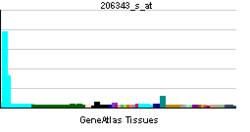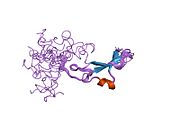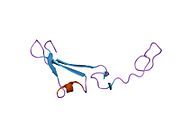- Neuregulin 1
-
Neuregulin 1 or NRG1 is a protein which in humans is encoded by the NRG1 gene.[1][2] NRG1 is one of four proteins in the neuregulin family that act on the EGFR family of receptors. Neuregulin 1 is produced in numerous isoforms by alternative splicing, which allows it to perform a wide variety of functions. It is essential for the normal development of the nervous system and the heart.[3][4]
Contents
Function
Neuregulin 1 (NRG1) was originally identified as a 44-kD glycoprotein that interacts with the NEU/ERBB2 receptor tyrosine kinase to increase its phosphorylation on tyrosine residues. It is known that an extraordinary variety of different isoforms are produced from the NRG1 gene by alternative splicing. These isoforms include heregulins (HRGs), glial growth factors (GGFs) and sensory and motor neuron-derived factor (SMDF). They are tissue-specifically expressed and differ significantly in their structure. The HRG isoforms all contain immunoglobulin (Ig) and epidermal growth factor-like (EGF-like) domains. GGF and GGF2 isoforms contain a kringle-like sequence plus Ig and EGF-like domains; and the SMDF isoform shares only the EGF-like domain with other isoforms. The receptors for all NRG1 isoforms are the ERBB family of tyrosine kinase transmembrane receptors. Through interaction with ERBB receptors, NRG1 isoforms induce the growth and differentiation of epithelial, neuronal, glial, and other types of cells.[5]
Isoforms
At least six major types (different N termini) of neuregulin 1 are known.[6] Six types exist in humans and rodents (type I, II and III NRG1 are expressed in excitatory and inhibitory neurons, as well as astrocytes), and some types (I and IV) can be regulated by neuronal activity.[7]
type aliases I Heregulin, NEU differentiation factor (NDF), or acetylcholine receptor inducing activity (ARIA) II Glial Growth Factor-2 (GGF2) III Sensory and motor neuron-derived factor (SMDF) IV V VI Clinical significance
Neuregulin 1-ErbB4 interactions are thought to play a role in the pathological mechanism of schizophrenia.[8][9] A high-risk deCODE (Icelandic) haplotype was discovered in 2002 on the 5'-end of the gene.[10] The SNP8NRG243177 allele from this haplotype was associated in 2006 with a heightened expression of the Type IV NRG1 in the brains of people suffering from schizophrenia.[11][12] The protein also has the putative ability to protect the brain from damage induced by stroke.[13] Those with a genetic variant of neuregulin 1 tended to be more creative.[14]
There is evidence that NRG1 is a tumour suppressor gene.[15]
Interactions
Neuregulin 1 has been shown to interact with ERBB3[16][17][18] and LIMK1.[19]
References
- ^ Holmes WE, Sliwkowski MX, Akita RW, Henzel WJ, Lee J, Park JW, Yansura D, Abadi N, Raab H, Lewis GD (May 1992). "Identification of heregulin, a specific activator of p185erbB2". Science 256 (5060): 1205–10. doi:10.1126/science.256.5060.1205. PMID 1350381.
- ^ Orr-Urtreger A, Trakhtenbrot L, Ben-Levy R, Wen D, Rechavi G, Lonai P, Yarden Y (March 1993). "Neural expression and chromosomal mapping of Neu differentiation factor to 8p12-p21". Proc. Natl. Acad. Sci. U.S.A. 90 (5): 1867–71. doi:10.1073/pnas.90.5.1867. PMC 45981. PMID 8095334. http://www.pubmedcentral.nih.gov/articlerender.fcgi?tool=pmcentrez&artid=45981.
- ^ Britsch S (2007). "The neuregulin-I/ErbB signaling system in development and disease". Adv Anat Embryol Cell Biol 190: 1–65. doi:10.1007/978-3-540-37107-6_1. PMID 17432114.
- ^ Talmage DA (2008). "Mechanisms of neuregulin action". Novartis Found. Symp. 289: 74–84; discussion 84–93. doi:10.1002/9780470751251.ch6. PMC 2621364. PMID 18497096. http://www.pubmedcentral.nih.gov/articlerender.fcgi?tool=pmcentrez&artid=2621364.
- ^ "Entrez Gene: NRG1 Neuregulin 1". http://www.ncbi.nlm.nih.gov/sites/entrez?Db=gene&Cmd=ShowDetailView&TermToSearch=3084.
- ^ Steinthorsdottir V, Stefansson H, Ghosh S, Birgisdottir B, Bjornsdottir S, Fasquel AC, Olafsson O, Stefansson K, Gulcher JR (November 2004). "Multiple novel transcription initiation sites for NRG1". Gene 342 (1): 97–105. doi:10.1016/j.gene.2004.07.029. PMID 15527969.
- ^ Liu X, Bates R, Yin DM, Shen C, Wang F, Su N, Kirov SA, Luo Y, Wang JZ, Xiong WC, Mei L (June 2011). "Specific Regulation of NRG1 Isoform Expression by Neuronal Activity". J. Neurosci. 31 (23): 8491–501. doi:10.1523/JNEUROSCI.5317-10.2011. PMID 21653853.
- ^ Li D, Collier DA, He L (June 2006). "Meta-analysis shows strong positive association of the neuregulin 1 (NRG1) gene with schizophrenia". Hum. Mol. Genet. 15 (12): 1995–2002. doi:10.1093/hmg/ddl122. PMID 16687441.
- ^ Gene Overview of All Published Schizophrenia-Association Studies for NRG1- SchizophreniaGene database, Schizophrenia Research Forum.
- ^ Stefansson H, Sigurdsson E, Steinthorsdottir V, Bjornsdottir S, Sigmundsson T, Ghosh S, Brynjolfsson J, Gunnarsdottir S, Ivarsson O, Chou TT, Hjaltason O, Birgisdottir B, Jonsson H, Gudnadottir VG, Gudmundsdottir E, Bjornsson A, Ingvarsson B, Ingason A, Sigfusson S, Hardardottir H, Harvey RP, Lai D, Zhou M, Brunner D, Mutel V, Gonzalo A, Lemke G, Sainz J, Johannesson G, Andresson T, Gudbjartsson D, Manolescu A, Frigge ML, Gurney ME, Kong A, Gulcher JR, Petursson H, Stefansson K (October 2002). "Neuregulin 1 and susceptibility to schizophrenia". Am. J. Hum. Genet. 71 (4): 877–92. doi:10.1086/342734. PMC 378543. PMID 12145742. http://www.pubmedcentral.nih.gov/articlerender.fcgi?tool=pmcentrez&artid=378543.
- ^ Law AJ, Lipska BK, Weickert CS, Hyde TM, Straub RE, Hashimoto R, Harrison PJ, Kleinman JE, Weinberger DR (April 2006). "Neuregulin 1 transcripts are differentially expressed in schizophrenia and regulated by 5' SNPs associated with the disease". Proc. Natl. Acad. Sci. U.S.A. 103 (17): 6747–52. doi:10.1073/pnas.0602002103. PMC 1458952. PMID 16618933. http://www.pubmedcentral.nih.gov/articlerender.fcgi?tool=pmcentrez&artid=1458952.
- ^ Hall J, Whalley HC, Job DE, Baig BJ, McIntosh AM, Evans KL, Thomson PA, Porteous DJ, Cunningham-Owens DG, Johnstone EC, Lawrie SM (December 2006). "A neuregulin 1 variant associated with abnormal cortical function and psychotic symptoms". Nat. Neurosci. 9 (12): 1477–8. doi:10.1038/nn1795. PMID 17072305.
- ^ Xu Z, Croslan DR, Harris AE, Ford GD, Ford BD (2006). "Extended therapeutic window and functional recovery after intraarterial administration of neuregulin-1 after focal ischemic stroke". J. Cereb. Blood Flow Metab. 26 (4): 527–35. doi:10.1038/sj.jcbfm.9600212. PMID 16136057.
- ^ Kéri, S (Sep 2009). "Genes for psychosis and creativity: a promoter polymorphism of the neuregulin 1 gene is related to creativity in people with high intellectual achievement.". Psychol Sci 20 (9): 1070–3. doi:10.1111/j.1467-9280.2009.02398.x. PMID 19594860. Lay summary – The Daily Galaxy: Great Discoveries Channel.
- ^ Chua YL, Ito Y, Pole JC, Newman S, Chin SF, Stein RC, Ellis IO, Caldas C, O'Hare MJ, Murrell A, Edwards PA (October 2009). "The NRG1 gene is frequently silenced by methylation in breast cancers and is a strong candidate for the 8p tumour suppressor gene". Oncogene 28 (46): 4041–52. doi:10.1038/onc.2009.259. PMC 2789334. PMID 19802002. http://www.pubmedcentral.nih.gov/articlerender.fcgi?tool=pmcentrez&artid=2789334.
- ^ Singer E, Landgraf R, Horan T, Slamon D, Eisenberg D (November 2001). "Identification of a heregulin binding site in HER3 extracellular domain". J. Biol. Chem. 276 (47): 44266–74. doi:10.1074/jbc.M105428200. PMID 11555649.
- ^ Horan T, Wen J, Arakawa T, Liu N, Brankow D, Hu S, Ratzkin B, Philo JS (October 1995). "Binding of Neu differentiation factor with the extracellular domain of Her2 and Her3". J. Biol. Chem. 270 (41): 24604–8. doi:10.1074/jbc.270.41.24604. PMID 7592681.
- ^ Carraway KL, Weber JL, Unger MJ, Ledesma J, Yu N, Gassmann M, Lai C (May 1997). "Neuregulin-2, a new ligand of ErbB3/ErbB4-receptor tyrosine kinases". Nature 387 (6632): 512–6. doi:10.1038/387512a0. PMID 9168115.
- ^ Wang JY, Frenzel KE, Wen D, Falls DL (August 1998). "Transmembrane neuregulins interact with LIM kinase 1, a cytoplasmic protein kinase implicated in development of visuospatial cognition". J. Biol. Chem. 273 (32): 20525–34. doi:10.1074/jbc.273.32.20525. PMID 9685409.
Further reading
- Lupu R, Lippman ME (1994). "William L. McGuire Memorial Symposium. The role of erbB2 signal transduction pathways in human breast cancer.". Breast Cancer Res. Treat. 27 (1-2): 83–93. doi:10.1007/BF00683195. PMID 7903175.
- Corfas G, Roy K, Buxbaum JD (2004). "Neuregulin 1-erbB signaling and the molecular/cellular basis of schizophrenia.". Nat. Neurosci. 7 (6): 575–80. doi:10.1038/nn1258. PMID 15162166.
- Harrison PJ, Law AJ (2006). "Neuregulin 1 and schizophrenia: genetics, gene expression, and neurobiology.". Biol. Psychiatry 60 (2): 132–40. doi:10.1016/j.biopsych.2005.11.002. PMID 16442083.
- Munafò MR, Thiselton DL, Clark TG, Flint J (2006). "Association of the NRG1 gene and schizophrenia: a meta-analysis.". Mol. Psychiatry 11 (6): 539–46. doi:10.1038/sj.mp.4001817. PMID 16520822.
External links
- MeSH Neuregulin-1
- 'New way' to repair heart damage
- NRG1 rs3924999, hypothetical major gene locus of general intelligence
- Links from Schizophrenia Research Forum:
- Neuregulin, ErbB4—Levels Normal but Signaling Strengthened in Schizophrenia - 18 June 2006.
- Neuregulin and ErbB4 Mutant Mice Reveal Myelin and Synaptic Deficits - 2 May 2007.
- Functional Neuregulin Variant Linked to Psychosis, Abnormal Brain Activation and IQ - 30 October 2006.
- Neuregulin, ErbB4 Drive Developmental Cell Fates
- Neuregulin Partner ErbB4 Spices Up Genetic Associations - 17 February 2005
- Polymorphisms and Schizophrenia—The Ups and Downs of Neuregulin Expression - 21 April 2006.
- Neuregulin Studies Suggest Synaptic Deficits in Schizophrenia - 4 June 2007
This article incorporates text from the United States National Library of Medicine, which is in the public domain.
PDB gallery 1hae: HEREGULIN-ALPHA EPIDERMAL GROWTH FACTOR-LIKE DOMAIN, NMR, 20 STRUCTURES1haf: HEREGULIN-ALPHA EPIDERMAL GROWTH FACTOR-LIKE DOMAIN, NMR, MINIMIZED AVERAGE STRUCTURE1hre: SOLUTION STRUCTURE OF THE EPIDERMAL GROWTH FACTOR-LIKE DOMAIN OF HEREGULIN-ALPHA, A LIGAND FOR P180ERB41hrf: SOLUTION STRUCTURE OF THE EPIDERMAL GROWTH FACTOR-LIKE DOMAIN OF HEREGULIN-ALPHA, A LIGAND FOR P180ERB4Cell signaling: nervous tissue: neurotrophin Trk binding GFL Other Categories:- Human proteins
- Proteins
Wikimedia Foundation. 2010.






